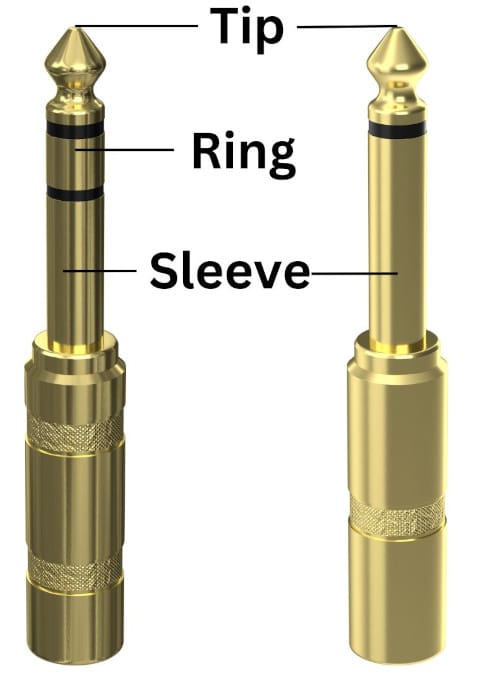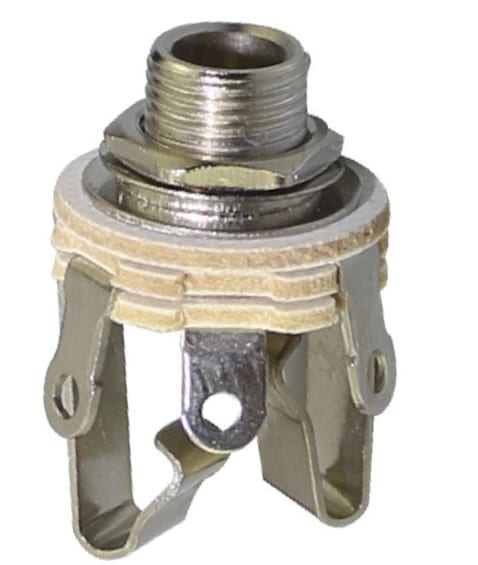Table of Contents
In the realm of guitars, the choice between mono and stereo jacks might seem trivial. Yet, this decision can influence the very essence of your sound. Mono jacks have long been the standard. But the allure of stereo jacks and their capabilities is undeniable.
But let’s just get to the point, are guitar jacks mono or stereo? Guitar jacks are predominantly mono. If your guitar has passive pickups, it’s mono by default. But if it’s active, then there is a chance that it’s a stereo jack connection. Although this is quite rare.
Not every device is compatible, which is the main consideration. This Killer Rig article is geared to unravel the intricacies of guitar jacks.
Mono vs. Stereo: An Overview
When it comes to guitar jacks, understanding the fundamental differences between mono and stereo options is crucial. Each has its own set of characteristics and applications.

Mono Jacks
Mono jacks are the traditional choice for most guitars. Their design is straightforward, and their purpose is singular.
- Definition: A mono jack is designed to transmit a single audio channel. This simplicity makes it the go-to choice for a vast majority of guitars.
Visual Representation:
Mono jacks can be easily identified by their design. They typically feature:
- A single ring on their tip.
- Two contact points: the tip and the sleeve.
Applications:
Mono jacks are versatile and are used in:
- Standard electric guitars.
- Acoustic guitars with basic electronic pickups.
- Most guitar amplifiers.
Stereo Jacks
Stereo jacks, while less common, offer more complexity and versatility, especially for specialized guitar setups.
- Definition: A stereo jack is capable of transmitting two separate audio channels. This dual-channel setup is often referred to as the left and right channels.
Visual Representation:
Distinguishing features of stereo jacks include:
- Two rings on their tip, indicating the dual channels.
- Three contact points: the tip, ring, and sleeve.
Applications:
Stereo jacks find their place in:
- Guitars with active pickups or preamps that require additional power or signal routing.
- Situations where separate audio channels are beneficial, such as split signal processing.
In the subsequent sections, we’ll delve deeper into the specific characteristics, advantages, and use cases of each jack type.
Mono Jacks: A Closer Look
While the basic design and applications of mono jacks are clear, there’s more to these jacks than meets the eye. Let’s look deeper into their intricacies.

Historical Context
Mono jacks have been a part of the guitar landscape for decades. Their simplicity and reliability made them the default choice as electric guitars gained popularity in the mid-20th century.
Technical Aspects
- Contact Points: The two contact points in a mono jack, the tip and the sleeve, correspond to the live signal and ground, respectively.
- Signal Transmission: Mono jacks provide an unbalanced signal, which is suitable for short cable runs typically used with guitars.
- Durability: Their robust construction ensures longevity, even with regular plugging and unplugging.
Beyond Standard Applications
While most commonly found in standard electric and acoustic guitars, mono jacks also have specialized uses:
- Effects Pedals: Many guitar effects pedals utilize mono jacks for input and output. This ensures compatibility with standard guitar setups.
- Vintage Guitars: Older guitar models, especially those from the mid-20th century, exclusively feature mono jacks, preserving the original sound and design.
Potential Limitations
- Interference: Being unbalanced, mono jacks can be susceptible to interference over longer cable runs.
- Lack of Versatility: For guitars with advanced electronics or those requiring separate signal paths, mono jacks might not be the ideal choice.
Longer cable runs with mono connections can also create capacitance, causing treble loss in the overall tone of the guitar.
Stereo Jacks: Beyond the Dual Channels
Stereo jacks, though less common in standard guitar setups, bring a layer of complexity and versatility that can be invaluable in specific scenarios.

Technical Insights
- Contact Points: Stereo jacks, often referred to as TRS (Tip-Ring-Sleeve) jacks, have three contact points. These correspond to the left channel (tip), right channel (ring), and ground (sleeve).
- Balanced Signals: One of the advantages of stereo jacks is their ability to carry balanced signals. This reduces the risk of interference, especially over longer cable runs.
Specialized Applications
Stereo jacks aren’t just about left and right audio channels. Their design allows for specific applications:
- Active Pickups: Guitars equipped with active pickups or preamps often require an additional power source. Stereo jacks can facilitate this by routing the battery’s negative terminal through the ring contact.
- Kill Switches: Some guitarists use the additional contact point in stereo jacks as a kill switch, allowing them to mute their instrument without adjusting the volume.
Advantages of Stereo Jacks
- Versatility: The additional contact point provides flexibility in signal routing, making it suitable for advanced guitar electronics.
- Reduced Interference: The balanced signal capability can lead to cleaner sound transmission, especially in environments with potential electronic interference.
Challenges and Considerations
- Compatibility: Not all amplifiers and audio equipment are compatible with stereo outputs. Guitarists need to ensure their entire signal chain can accommodate a stereo jack.
- Cost: Guitars equipped with stereo jacks or those requiring modifications to accommodate them can be more expensive than their mono counterparts.
In essence, mono jacks cater to the majority of guitarists. But stereo jacks offer advanced functionalities that can be crucial for specific setups and requirements. Their benefits, however, come with their own set of challenges that guitarists should be aware of.
Special Jack Types: Exploring the Variants
Mono and stereo jacks cover a significant portion of the guitar world. But there are other jack types that cater to specialized needs and offer specific functionalities.
Skeleton Jacks

These jacks are designed with no housing or cover, allowing users to see the inner components.
- Advantages:
- Easier troubleshooting: By visually inspecting the jack, one can identify issues like loose connections or solder breaks.
- Aesthetic appeal: For some guitarists, the ability to see the inner workings adds a neat visual element to their instrument.
Barrel Jacks
These have a cylindrical design, differing from the typical open-frame construction of most guitar jacks.
- Features:
- Compact design: Suitable for guitars with limited space for electronics.
- Durability: The enclosed design can offer better protection against dust and moisture.
Switched Jacks
A more advanced type, switched jacks come with additional prongs, offering more versatility in signal routing.
- Functionality:
- Multiple electronic components: Guitars with complex electronics can benefit from the additional prongs, allowing for intricate signal paths.
- Kill switches or muting functions: The extra prongs can be used to create a kill switch, providing guitarists with more control over their sound.
Considerations When Choosing a Special Jack Type
- Compatibility: Ensure that the chosen jack type is compatible with the guitar’s design and electronics.
- Installation: Some special jack types might require professional installation or modifications to the guitar.
- Cost: Advanced jack types can be more expensive, both in terms of the component and potential installation fees.
Practical Considerations
Choosing the right jack for a guitar isn’t just about understanding the technical differences; it’s also about weighing the practical implications of that choice.
Cost Implications
- Mono Jacks:
- Generally more affordable due to their widespread use and simpler design.
- Installation and replacement costs are typically lower.
- Stereo Jacks:
- Tend to be more expensive due to their complex design and specialized applications.
- May incur additional costs if the guitar requires modifications to accommodate the stereo setup.
Usability
- Mono Jacks:
- Universally compatible with a vast majority of amplifiers and audio equipment.
- Simplified setup makes it easier for beginners and those looking for a plug-and-play experience.
- Stereo Jacks:
- Require specific equipment or amplifiers that can handle stereo signals.
- Might necessitate additional cables or adapters for certain setups.
Sound Quality
- Mono Jacks:
- Suitable for most standard guitar setups, delivering a consistent sound quality.
- Potential for interference in longer cable runs due to unbalanced signals.
- Stereo Jacks:
- Offer the potential for enhanced sound quality in specific scenarios, especially with active pickups or preamps.
- Balanced signals can reduce interference, leading to a cleaner sound over longer distances.
FAQs
Can I use a stereo cable for a mono guitar?
Yes, you can use a stereo cable for a mono guitar. However, only one of the channels (usually the tip) will carry the signal, while the other remains unused.
It’s essential to ensure that the cable’s end connecting to the amplifier or audio equipment is compatible.
Are stereo jacks better than mono?
Not necessarily. While stereo jacks offer more capabilities, the choice between them depends on the specific requirements of the guitar setup. For many standard guitars, mono jacks are sufficient.
Can I convert my guitar from mono to stereo?
Yes, but it may require modifications, including changing the internal wiring and possibly the pickups. It’s advisable to consult with a professional before making such changes.
Why are mono jacks more common in guitars?
Mono jacks are more prevalent due to their simplicity, cost-effectiveness, and compatibility with a wide range of amplifiers and audio equipment. And because passive pickups only send one signal, mono is the best choice.
Do stereo jacks improve sound quality?
In specific scenarios, especially with active pickups or preamps, stereo jacks can offer enhanced sound quality. However, for most standard guitar setups, the difference in sound quality between mono and stereo jacks is negligible.
What are switched jacks?
Switched jacks come with additional prongs, offering more versatility in signal routing. They can be used in guitars with complex electronics or for functionalities like kill switches.

